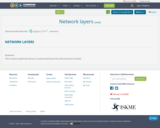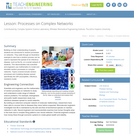
This content enable the learner to understand about the network layers in detail.
- Subject:
- Applied Science
- Computer Science
- Engineering
- Material Type:
- Activity/Lab
- Primary Source
- Student Guide
- Date Added:
- 08/27/2019

This content enable the learner to understand about the network layers in detail.

Building on their understanding of graphs, students are introduced to random processes on networks. They walk through an illustrative example to see how a random process can be used to represent the spread of an infectious disease, such as the flu, on a social network of students. This demonstrates how scientists and engineers use mathematics to model and simulate random processes on complex networks. Topics covered include random processes and modeling disease spread, specifically the SIR (susceptible, infectious, resistant) model.

With the expansion of huge and complex real time data that is wandering across the internet today, the dimensions of data transmitted are escalating exponentially with each passing years. This makes working with standard database systems or on personal computers difficult because of its inability to handle outsized, unstructured and complicated data. Various institutes stores and uses massive amounts of data which are further utilized for generating reports to guarantee stability regarding the services they proposes. However, the challenge is how to analyze, capture, share, store, transfer, visualize, query, update and finally manipulate an impressive volume of data that has to be delivered through the internet to reach its destination intact maintaining its information privacy. Almost all the applications developed using any programming languages requires some external component to store and access data. The components for the same could be a local network, a cloud file or even a database. While sources like the network and cloud file systems store the unstructured data, the structured data is usually stored in a typical Relational Database Management System or RDBMS. The RDBMS operates with relational data model using schema for storing data into tables and is usually queried with SQL (Structured Query Language) for data operations. Usually it’s a time consuming process to define, structure, distribute and access data from RDBMS through SQL and hence, an alternative was developed for this called the NoSQL ("Non SQL", "Non relational" or "Not only SQL") database. This edited book chapter provides NoSQL databases hands on and attention has been paid to various types of NoSQL databases focusing on the details such as installation, creation, modification and various updation of one database belonging to each type.

To get a better understanding of complex networks, students create their own, real social network example by interacting with their peers in the classroom and documenting the interactions. They represent the interaction data as a graph, calculate two mathematical quantities associated with the graph—the degree of each node and the degree distribution of the graph—and analyze how these quantities can be used to infer properties of the social network at hand.

This class is an applications-oriented course covering the modeling of large-scale systems in decision-making domains and the optimization of such systems using state-of-the-art optimization tools. Application domains include: transportation and logistics planning, pattern classification and image processing, data mining, design of structures, scheduling in large systems, supply-chain management, financial engineering, and telecommunications systems planning. Modeling tools and techniques include linear, network, discrete and nonlinear optimization, heuristic methods, sensitivity and post-optimality analysis, decomposition methods for large-scale systems, and stochastic optimization.
This course was also taught as part of the Singapore-MIT Alliance (SMA) programme as course number SMA 5223 (System Optimisation: Models and Computation).

This collection uses primary sources to explore the Underground Railroad and the Fugitive Slave Act of 1850. Digital Public Library of America Primary Source Sets are designed to help students develop their critical thinking skills and draw diverse material from libraries, archives, and museums across the United States. Each set includes an overview, ten to fifteen primary sources, links to related resources, and a teaching guide. These sets were created and reviewed by the teachers on the DPLA's Education Advisory Committee.

Students analyze dramatic works using graph theory. They gather data, record it in Microsoft Excel and use Cytoscape (a free, downloadable application) to generate graphs that visually illustrate the key characters (nodes) and connections between them (edges). The nodes in the Cytoscape graphs are color-coded and sized according to the importance of the node (in this activity nodes represent characters in the work and their relative importance to the story). After the analysis, the graphs are further examined to see what the visual depiction of the story in the form of a graph tells readers about the inner workings of the dramatic work. Students gain practice with graph theory vocabulary, including node, edge, betweeness centrality and degree on interaction, and learn about a range of engineering applications of graph theory.

Security in network is verry important for keep safe network sharing. For this, the woreless router must to be secure with one of two disponible metode WEP or WPA/WPA2 with cryptographic encription TKIP or AES.